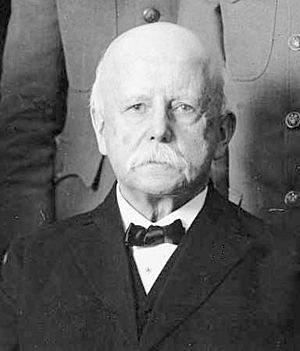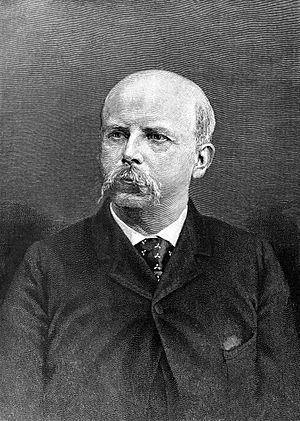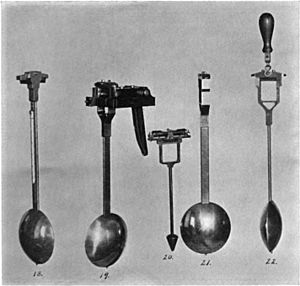Thomas Corwin Mendenhall facts for kids
Quick facts for kids
Thomas Corwin Mendenhall
|
|
|---|---|
 |
|
| Born | October 4, 1841 Hanoverton, Ohio, US
|
| Died | March 28, 1924 (aged 82) Ravenna, Ohio, US
|
| Alma mater | Ohio State University |
| Known for | |
| Spouse(s) |
Susan Allan Marple
(m. 1870) |
| Children | Charles Elwood Mendenhall |
| Relatives | Thomas C. Mendenhall (grandson) |
| Awards | Cullum Geographical Medal (1901) Franklin Medal (1918) Order of the Sacred Treasure (Japan) (1911) |
| Scientific career | |
| Fields |
|
| Influences | Augustus De Morgan |
| Influenced | Yamakawa Kenjirō Tanakadate Aikitsu |
| Signature | |
Thomas Corwin Mendenhall (born October 4, 1841, died March 23, 1924) was an American scientist. He taught himself a lot about physics and weather. He was the very first professor hired at Ohio State University in 1873. Later, he led the U.S. Coast and Geodetic Survey (now called NOAA) from 1889 to 1894. Mendenhall strongly supported the United States using the metric system. He also helped create the field of author profiling, which studies writing styles.
Contents
Biography: The Life of a Scientist
Thomas Mendenhall was born in Hanoverton, Ohio. His father, Stephen Mendenhall, was a farmer and carriage-maker. In 1852, his family moved to Marlboro, Ohio, a Quaker community. His parents were strong supporters of ending slavery. They often welcomed escaped slaves traveling north on the Underground Railroad.
Mendenhall became the principal of a local primary school in 1858. He earned his teaching degree from National Normal University in 1861. In 1870, he married Susan Allan Marple in Columbus, Ohio. They had one son, Charles Elwood Mendenhall, who later became a physics professor.
Early Teaching Career
Mendenhall taught at several schools in Ohio, including Central High School. He became known as an excellent teacher. In 1873, even without a traditional college degree, he was hired as a professor of physics at the Ohio Agricultural and Mechanical College. This college later became Ohio State University. Mendenhall was the first professor ever hired there. In 1878, Ohio State University gave him its first honorary Ph.D. degree.
Work in Japan
In 1878, Mendenhall was invited to Japan to help with their modernization. This was during the Meiji Era. He became a visiting professor of physics at Tokyo Imperial University. While in Japan, he started a weather observatory. He made careful observations of the weather.
He also measured the force of gravity at sea level and on top of Mount Fuji. From these measurements, he calculated the mass of the Earth. His result was very close to other estimates. Mendenhall also studied earthquakes in Japan. He helped start the Seismological Society of Japan (SSJ). He even gave public science lectures in temples and theaters.
Return to the United States
Mendenhall returned to Ohio in 1881. He helped create the Ohio State Meteorological Service. He also designed a system of weather signals for trains. This system was later used across the United States and Canada.
In 1884, he became a professor at the U.S. Signal Corps. He started studying lightning and ground temperatures. He also set up the first stations in the United States to observe earthquakes regularly.
Leading the U.S. Coast and Geodetic Survey
Mendenhall became the superintendent of the U.S. Coast and Geodetic Survey in 1889. During this time, he issued the Mendenhall Order. This order helped the United States switch its weights and measures from the old system to the metric system. Mendenhall always believed the metric system should be officially adopted. He also helped define the exact border between Alaska and Canada. The Mendenhall Valley and Mendenhall Glacier in Juneau, Alaska were named after him in 1892.
In 1890, Mendenhall invented the portable Mendenhall Gravimeter. This device could measure the Earth's local gravitational field very accurately. These gravimeters were used at over 340 survey stations around the world. The pendulum in his gravimeter was more accurate than the best clocks of that time. Albert A. Michelson used it to measure the speed of light, which helped him win a Nobel Prize. An early Mendenhall Gravimeter is on display at the Smithsonian Institution in Washington, D.C.
Later Years

Mendenhall was president of the Worcester Polytechnic Institute from 1894 to 1901. He then moved to Europe and returned to the United States in 1912. In 1919, he joined the board of trustees at Ohio State University. He passed away in Ravenna, Ohio, in 1924.
His portrait is now at the National Portrait Gallery in Washington, D.C. It was painted by his former student, Annie W. S. Siebert. Another portrait was painted by artist George Bellows in 1913.
Work on Stylometry: Analyzing Writing Styles
In 1887, Mendenhall published one of the first studies on stylometry. This field is also known as author profiling. It uses numbers to analyze writing style. An English mathematician named Augustus De Morgan had suggested this idea in 1851. Mendenhall tried to figure out an author's style by looking at how often words of different lengths appeared in their writing.
Mendenhall thought this method could help answer the Shakespeare authorship question. This question asks if someone else, like Sir Francis Bacon, wrote Shakespeare's plays. Mendenhall hired people to count words in the plays. However, the results did not strongly support the idea that Bacon was the author.
In 1901, Mendenhall also analyzed works by Christopher Marlowe. He found that Marlowe's writing style was very similar to Shakespeare's. This finding was interesting to those who believe Marlowe might have written Shakespeare's plays.
Honors and Recognition
- Honorary Ph.D. from The Ohio State University (1878)
- Honorary Ph.D. from University of Michigan (1887)
- Member of the National Academy of Sciences (1887)
- President of the American Association for the Advancement of Science (1889)
- The Mendenhall Valley and Mendenhall Glacier in Juneau, Alaska were named for him (1892)
- Elected a member of the American Antiquarian Society (1895)
- Cullum Geographical Medal from the American Geographical Society (1901)
- Order of the Sacred Treasure, Japan (1911)
- Honorary Ph.D. from Case Western Reserve University (1912)
- Franklin Medal (1918)
- Mendenhall Laboratory at Ohio State University is named for him





